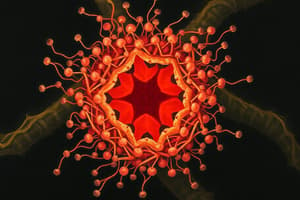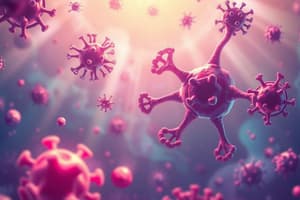Podcast
Questions and Answers
What is the primary function of agglutination in the immune response?
What is the primary function of agglutination in the immune response?
Which immunoglobulin subclass is primarily associated with allergic reactions?
Which immunoglobulin subclass is primarily associated with allergic reactions?
Which immune cells recognize antigens through MHC I molecules?
Which immune cells recognize antigens through MHC I molecules?
What characteristic distinguishes adaptive immunity from innate immunity?
What characteristic distinguishes adaptive immunity from innate immunity?
Signup and view all the answers
What is the role of macrophages in the innate immune system?
What is the role of macrophages in the innate immune system?
Signup and view all the answers
Which of the following is NOT a characteristic of adaptive immunity?
Which of the following is NOT a characteristic of adaptive immunity?
Signup and view all the answers
What type of antigens does MHC II molecules primarily bind and present?
What type of antigens does MHC II molecules primarily bind and present?
Signup and view all the answers
Which mechanism is NOT part of innate immunity?
Which mechanism is NOT part of innate immunity?
Signup and view all the answers
What percentage of plasma is composed of water?
What percentage of plasma is composed of water?
Signup and view all the answers
Which plasma protein is responsible for maintaining osmotic pressure in the blood?
Which plasma protein is responsible for maintaining osmotic pressure in the blood?
Signup and view all the answers
What role do alpha and beta globulins serve in plasma?
What role do alpha and beta globulins serve in plasma?
Signup and view all the answers
Which component accounts for approximately 54 percent of the total plasma protein content?
Which component accounts for approximately 54 percent of the total plasma protein content?
Signup and view all the answers
What type of leukocytes produce immunoglobulins?
What type of leukocytes produce immunoglobulins?
Signup and view all the answers
Which of the following is NOT a function of albumin?
Which of the following is NOT a function of albumin?
Signup and view all the answers
Which group of plasma proteins is primarily involved in immunity?
Which group of plasma proteins is primarily involved in immunity?
Signup and view all the answers
Which substance is found in smaller quantities in plasma compared to plasma proteins?
Which substance is found in smaller quantities in plasma compared to plasma proteins?
Signup and view all the answers
What defines humoral immunity?
What defines humoral immunity?
Signup and view all the answers
Which of the following cells is primarily involved in cell-mediated immunity?
Which of the following cells is primarily involved in cell-mediated immunity?
Signup and view all the answers
Which type of pathogens does humoral immunity specifically protect against?
Which type of pathogens does humoral immunity specifically protect against?
Signup and view all the answers
What is a key difference in antibody formation between humoral and cell-mediated immunity?
What is a key difference in antibody formation between humoral and cell-mediated immunity?
Signup and view all the answers
What kind of cells responds to aberrant MHC markers in cell-mediated immunity?
What kind of cells responds to aberrant MHC markers in cell-mediated immunity?
Signup and view all the answers
How is the onset of humoral immunity different from cell-mediated immunity?
How is the onset of humoral immunity different from cell-mediated immunity?
Signup and view all the answers
Which statement about the end results of humoral and cell-mediated immunity is true?
Which statement about the end results of humoral and cell-mediated immunity is true?
Signup and view all the answers
Which cells are notable in their function within both humoral and cell-mediated immunity?
Which cells are notable in their function within both humoral and cell-mediated immunity?
Signup and view all the answers
What percentage of total plasma protein volume is made up by globulins?
What percentage of total plasma protein volume is made up by globulins?
Signup and view all the answers
Which of the following substances is primarily responsible for blood clotting?
Which of the following substances is primarily responsible for blood clotting?
Signup and view all the answers
Which plasma function is associated with the transportation of nutrients throughout the body?
Which plasma function is associated with the transportation of nutrients throughout the body?
Signup and view all the answers
Which plasma protein is primarily synthesized to maintain osmotic pressure?
Which plasma protein is primarily synthesized to maintain osmotic pressure?
Signup and view all the answers
Which function of plasma involves transporting respiratory gases?
Which function of plasma involves transporting respiratory gases?
Signup and view all the answers
What role does fibrinogen play regarding erythrocyte sedimentation rate (ESR)?
What role does fibrinogen play regarding erythrocyte sedimentation rate (ESR)?
Signup and view all the answers
Which of the following is NOT a function of plasma?
Which of the following is NOT a function of plasma?
Signup and view all the answers
Which component found in plasma is key in the body's defense mechanism?
Which component found in plasma is key in the body's defense mechanism?
Signup and view all the answers
Study Notes
Antibodies
- Antibodies, also known as immunoglobulins, are proteins.
- They exhibit specificity, categorized into five immunoglobulin subclasses: IgG, IgA, IgM, IgD, and IgE.
- Antibody functions include agglutination (Ag-Ab reaction), neutralization (covering toxic sites of antigens), and lysis (direct attack and rupturing of cells).
Antigen Presentation
- Dendritic cells, macrophages, and B lymphocytes present antigens.
- Antigens are displayed on the cell surface via MHC molecules.
- MHC class II molecules present antigens to helper T cells (CD4+).
- MHC class I molecules present antigens to cytotoxic T cells (CD8+).
- Immunodominant epitopes are associated with MHC II and presented on the cell surface.
Processing and Presentation of Antigens
- Antigens can be exogenous (processed via endocytic pathway) or endogenous (processed via cytosolic pathway).
- Exogenous antigens are ingested via endocytosis or phagocytosis.
- Endogenous antigens (from within the cell) are produced within cells.
- MHC molecules bind processed antigens within the endoplasmic reticulum (ER).
- CD8 T cells recognize antigens presented through MHC I.
T-cell Activity
- Cytotoxic T cells (Tc cells) target virus-infected cells, cancer cells, and transplant tissues.
- Helper T cells (Th cells) stimulate both humoral and cell-mediated immunity.
- T cells have T cell receptors (TCR) and co-receptors like CD4 and CD8.
Types of Immunity
- Immunity can be innate or adaptive.
- Innate immunity is the first line of defense, non-specific, acting within hours.
- Innate barriers include physical and chemical barriers (skin, mucous membranes, secretions), and cellular components (WBCs like basophils, eosinophils, macrophages, neutrophils, natural killer cells).
- Adaptive immunity is slower acting, specific, and has memory.
Adaptive Immunity Attributes
- Adaptive immunity exhibits antibody specificity, diversity, memory, and self-nonself recognition.
- Antibody specificity distinguishes minute differences in molecular structure.
- Diversity allows recognizing a wide array of molecular shapes.
- Memory enables quicker responses to previously encountered antigens.
- Self-nonself recognition ensures responses target foreign molecules only.
Humoral and Cell-Mediated Immunity
- Humoral immunity involves B cells that secrete antibodies to defend against extracellular pathogens.
- Cell-mediated immunity involves T cells that target infected cells, cancers, and transplants.
Humoral and Cell Mediated Immunity (alternative view)
- Humoral immunity targets extracellular antigens (like bacteria, viruses or fungi)
- Cell mediated immunity targets intracellular antigens (like virus-infected cells or cancer cells).
- B cells are crucial in humoral immunity.
- Helper T cells support both humoral and cell-mediated immunity.
- The cytotoxic T cell plays a crucial role in cell-mediated immunity.
Blood Plasma
- Blood plasma is the liquid portion of blood (mostly water).
- The major components are plasma proteins (albumin, globulins, fibrinogen), other plasma solutes, and functions of plasma.
- Plasma proteins include albumin, globulins, and fibrinogen, essential for osmotic pressure, blood clotting and immunity.
- Other plasma solutes include electrolytes, gases, nutrients, and metabolic waste products.
Blood plasma proteins
- Albumin is the most abundant plasma protein, contributing to osmotic pressure and transporting various substances.
- Globulins include alpha, beta, and gamma types, involved in transport functions, and immunity (antibodies).
- Fibrinogens are essential for blood clotting.
Studying That Suits You
Use AI to generate personalized quizzes and flashcards to suit your learning preferences.
Related Documents
Description
This quiz covers key concepts in immunology regarding antibodies and antigen presentation. Focus on the roles of immunoglobulin subclasses and the mechanisms of antigen processing and presentation. Test your understanding of immune responses and interactions between different immune cells.



